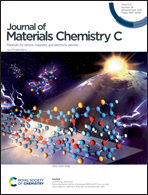Significantly enhanced thermoelectric performance in intermediate weak-coupling C8-BTBT molecular junctions with p/n-type electrode doping
Abstract
For single-molecular junctions, the inherent energy mismatch between the central molecule and electrodes requires a delicate balance between electronic and phonon transport properties. Based on a combination of density functional theory and the non-equilibrium Green's function method, we have proposed a C8-BTBT molecule that is displaced by means of an intermediate layer, and it is demonstrated that the weak-coupling can dramatically suppress phonon transport, resulting in a low phonon thermal conductance. Furthermore, we also find that the p/n-type electrode doping tunes both the electronic and phononic transport properties effectively, leading to a more than one order of magnitude increase in both the power factor and thermoelectronic figure-of-merit over the undoped system, which is attributed to the enhancement of the electronic density of states from the hybrid orbital to increase the Seebeck coefficient. Moreover, it is found that reducing the mass mismatch in the electrode structure is one of the key factors to increase phonon thermal conductance, and an excellent thermoelectronic figure-of-merit of 3.8/7.2 has been obtained by boron/nitrogen doping.



 Please wait while we load your content...
Please wait while we load your content...